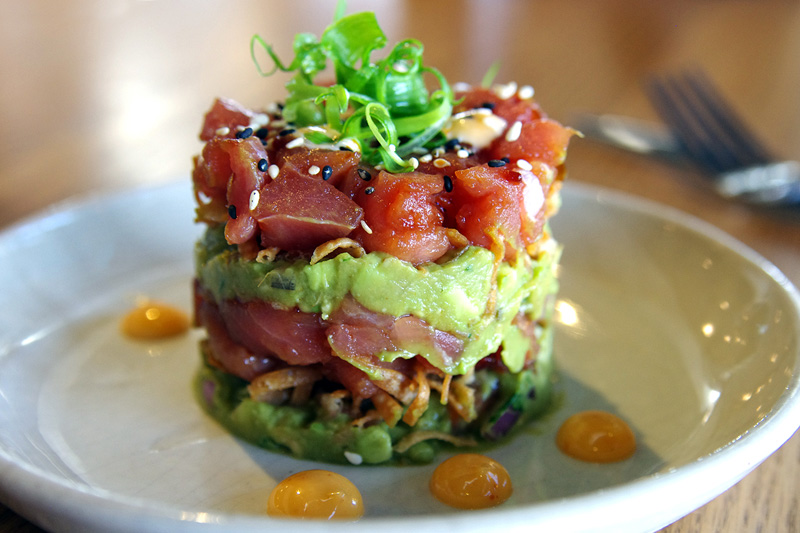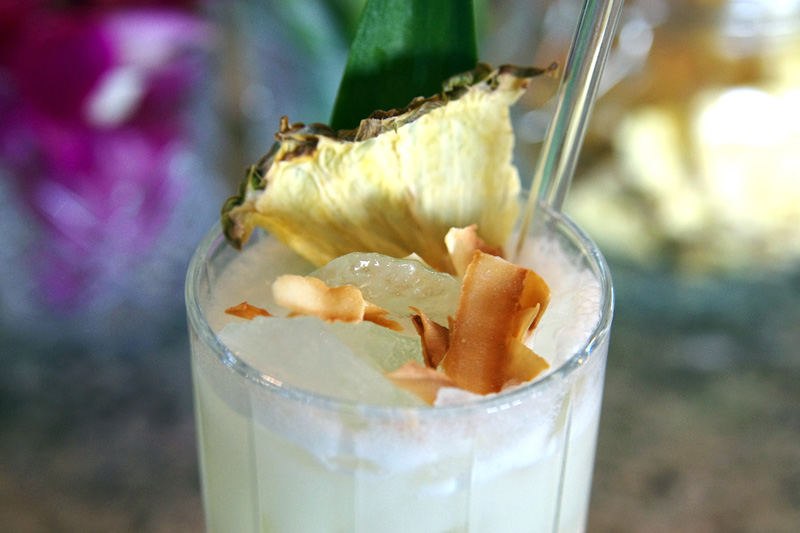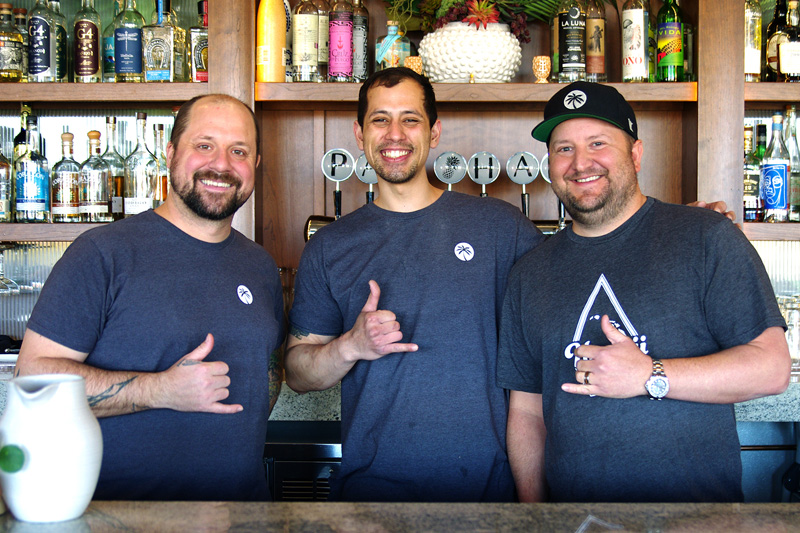PHOTOGRAPHS BY BRENDA JOHNSON / HEAVY TABLE
With its bright, airy interior and floral mural, Pau Hana is a tropical oasis in the southern suburbs. The sleek design and inviting bar makes it (nearly) impossible to deduce the building’s former iteration as a Perkins restaurant. In fact, Pau Hana owner and culinary director Chris Ikeda opened this particular Perkins with his dad in the early 2000s.
“I’m cooking on the same flat tops I was cooking on when I was a young kid,” he says with a laugh.

Ikeda is a familiar face in the local restaurant scene—he’s the owner and executive chef at Uptown standby Lake & Irving. Ikeda is pictured top, along with Bryan Gooding (Beverage Director, far left) and Kainalu Loa (Executive Chef, center). Like the location, Pau Hana’s menu (which Ikeda characterizes as “elevated Hawaiian Regional Cuisine”) is a return to his roots. During culinary school, he apprenticed at Hualalai Resort on Hawaii’s Big Island.
“I loved it so much,” he says. “I had to come back to New York to finish my degree, but the day I graduated I was on a plane back to Hawaii.”
Ikeda would go on to work at Hualalai Resort for nearly a decade, in an environment he describes as “a little culinary wonderland.” He worked with Chef Alan Wong (one of the founders of Hawaiian Regional Cuisine or HRC) and cites Hawaiian-born Chef James Ebreo as another major influence.
Ikeda’s interest in HRC was sparked by his Japanese heritage, and his time in Hawaii deepened his affinity.

“Hawaiian Regional Cuisine is a melting pot of all these different ethnicities and cultures from all around the world,” he explains. “You have Japanese, Korean, Chinese, Portuguese, Filipino, indigenous Hawaiian—all of those kind of blend together to create a cuisine that’s special and unique. It’s a really new cuisine—Hawaiian Regional Cuisine didn’t really start until the sugar cane days [in the late 1800s and early 1900s], with the immigration of plantation workers from all over the world.”
“That’s what’s so cool about it to me: you take all those different cultures and what they like to eat, and you blend it with the exotic fruits and fresh seafood and all the cool things you get from Hawaii.”
ISLAND CLASSICS REIMAGINED
Hawaiian Regional Cuisine remains a rarity in the Twin Cities dining scene—other than Pau Hana, the only other restaurant serving a robust HRC menu is the North Loop’s Ono Hawaiian Plates. That’s why the back of Pau Hana’s dinner menu offers a brief explanation of HRC, as well as a glossary of ingredients, cooking methods, and dishes. “You may not necessarily have heard of togarashi growing up in Shakopee your whole life,” says Ikeda. “It kind of breaks it all down [for our customers].”
Rather than being exact recreations of HRC classics, the dishes at Pau Hana use them as a starting point. For example, the loco moco (traditionally a couple of scoops of white rice, a beef patty, brown gravy, and a sunny-side up egg) is elevated with furikake sushi rice, a Japanese golden curry gravy, and the addition of coconut shrimp. One of the most popular dishes on the menu is the ahi loco moco, which swaps out the beef patty for seared ahi tuna.

Poke, an indigenous Hawaiian dish, has been reimagined as a precisely stacked appetizer, cubes of raw ahi tuna alternating with guacamole and tiny shreds of fried wontons. “It’s generally more approachable to someone who’s not necessarily going to order a poke bowl of raw fish,” says Ikeda.
Similarly, the house-smoked kalua pork (traditionally prepared by wrapping the meat in leaves and burying it in a pit atop hot coals) is mixed with risotto rice and fried into arancini-inspired rice balls. Lomi lomi salmon (typically a side dish of salt-cured salmon, tomatoes, and onions) is interpreted by Hawaiian-born executive chef Kainalu Loa as a tartine-style sandwich, with smoked salmon, a lomi lomi-inspired salsa, and shoyu cream cheese.
“We’re intermingling ingredients and techniques that are part of Hawaiian Regional Cuisine,” says Ikeda. “We’re doing it in our own special way, and we’re still cooking with intent and respect for what got us here.”
… AND HOLD THE PINEAPPLE, PLEASE
“It’s very visceral when you talk about Hawaii with someone,” he continues. “You have people who were born and raised there and never left the island, and you have people that got married there in the late ‘70s and had pineapple chicken and that’s what they associate Hawaii with. Everybody has their own vision of what [Hawaiian cuisine] is, right? Sometimes, that can get tough to break through and really have people understand what we’re trying to do. But most people are getting it.”

In the same vein, diners won’t find garishly hued, saccharine-sweet drinks on the cocktail menu. Beverage director Bryan Gooding describes the beverage program as “tropical but not tiki,” noting that tiki culture originated in California, not Hawaii. Instead, Pau Hana’s drinks are inspired by beaches around the world, with many relying on the versatility of rum (according to Gooding, the bar’s rum selection is the largest in the state). For instance, the Kona Mai Tai (above) is unexpectedly fruit-forward, the rum old fashioned tastes surprisingly like whiskey, and the Two If By Sea has an intense, almost savory coconut flavor.
At first glance, the fact that pizzas make up a significant portion of the Pau Hana menu may seem like a departure from Ikeda’s vision. But look a little closer—each pizza incorporates HRC ingredients in a thoughtful way.
“Kalua pork, Kalbi beef, and Portuguese sausage are all phenomenal ingredients that play into Hawaiian Regional Cuisine,” explains Ikeda. “I thought, ‘Those would work pretty well on pizzas, I’m going to give it a shot.’ And it turned out pretty well.”

“The Green Flash, I like that one because it’s our version of a margherita,” he continues. “A margherita pizza…How do we do that with intent, and make it something that’s Hawaiian Regional influenced? So we have our red sauce, and we have basil, but then we have Hawaiian chili pepper-brined mozzarella.” He explains that chili pepper water is a popular Hawaiian condiment consisting of ginger, garlic, and Hawaiian chilis mixed with vinegar and water. “We created a brine with that, and that’s what our mozzarella goes in. It’s got a little bit of heat to it, a slight tingle…We’re not trying to overcomplicate it, but we are still trying to distinguish it as being HRC.”
One pizza that’s not on the menu? A “Hawaiian” pizza topped with pineapple slices and bacon—despite the moniker, the popular pie hails from Canada and takes its name from a brand of canned pineapple.
“It comes back to that whole intent portion—we’re trying to do it right,” says Ikeda. “I love pineapple on pizza. But I think calling that a ‘Hawaiian’ pizza is not really true to what we’re trying to do.”
Pau Hana, 14435 State Highway 13, Savage, Minn., 952.447.1322, SUN 10am-2pm & 4pm-9pm, MON-THURS 4pm-9pm, FRI-SAT 4pm-10pm

